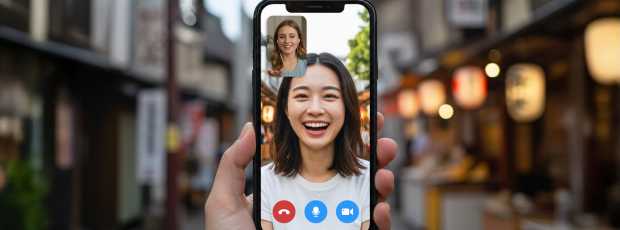Toshi was very knowledgeable, fluent in English, and made us feel out in town with a friend learning as much about the Japanese way of life and thinking as of the food scene. He even arranged the food tour to hidden gems near our hotel.Nina, Tokyo, 2025
Table Of Contents
- Making the Most of 3 Days in Tokyo
- Day One: Tsukiji to Ginza - Morning Fish Markets and Afternoon Wandering
- Day Two: Shibuya to Harajuku - Youth Culture and Creative Energy
- Day Three: Asakusa to Ueno - Traditional Culture and Hidden Creativity
- Practical Tokyo Tips for First Timers
- Food-Forward Tokyo: What Makes This City Special
- Hidden Creative Scenes: Beyond the Tourist Trail
- Planning Your Tokyo Itinerary: Practical Considerations
- Essential Tokyo Experiences for Creative Travelers
- Unique Tokyo Experiences for Short Visits
- Advanced Tokyo Navigation for Efficient Travel
- Final Recommendations: Making the Most of Your Time
- Tokyo's Lasting Impact
Three days in Tokyo isn't nearly enough, but it's enough to fall completely under this incredible city's spell.
I've been making my way through Tokyo's labyrinthine streets for over a decade, and what I've learned is this: the magic isn't in checking off landmarks.
It's in the 7am rush at Tsukiji Fish Market, the steam rising from a perfect ramen bowl, and the way afternoon light filters through a cramped Golden Gai bar that somehow fits eight people and infinite stories.
Born in Chiba but Tokyo-trained, I've watched this huge city evolve while staying fundamentally itself.
My approach to 3 days in Tokyo centers on food, creativity, and those in-between moments that make travel memorable.
This isn't about hitting every Instagram spot, it's about tasting, seeing, and feeling what makes Tokyo tick.
Is 3 Days in Tokyo Really Enough?
Let's be honest. Visiting Tokyo for just a few days feels like trying to read a novel by flipping through random pages.
But here's what I tell friends planning their first trip: three days in Tokyo can give you a genuine taste if you're strategic about it.
The key is depth over breadth. Instead of racing between distant neighborhoods, pick 2-3 areas and explore them properly.
Taste the Japanese food that defines each district. Notice how the vending machine selections change between Harajuku and Ginza.
Your Tokyo itinerary shouldn't feel like a marathon. The best travel memories come from moments when you stop rushing and start noticing.
Skip the Boring Script in Tokyo
Explore Tokyo’s food scene with a local who plans around you. It's flexible, flavorful, and never one-size-fits-all.
Day One: Tsukiji to Ginza - Morning Fish Markets and Afternoon Wandering
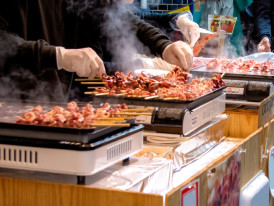
Tsukiji Outer Market.
Early Morning: Tsukiji Outer Market Adventure
Start your Tokyo itinerary day at 5:30am. Yes, it's brutal, but the former Tsukiji Fish Market area rewards early risers with experiences that define Tokyo for many visitors.
While the famous tuna auction moved to Toyosu, the Tsukiji outer market remains the heart of Tokyo's food culture.
The world's largest fish market legacy lives on in these narrow alleys packed with vendors who've been perfecting their craft for generations.
Head straight to a local restaurant for a legendary Japanese omelet. Watching the chef fold layer after layer of perfectly seasoned egg is such an experience that you'll forget you're standing in a crowd of other bleary-eyed food lovers.
The market can feel bit confusing with its maze of stalls, but that's part of its charm.
Follow your nose toward the best smells, and don't worry about having a perfect plan. The vendors here appreciate curiosity over efficiency.

The Imperial Palace.
Mid-Morning: Imperial Palace East Gardens
After the sensory overload of the fish market, the Imperial Palace East Gardens offer a different kind of Tokyo beauty.
These meticulously maintained gardens show off traditional Japanese landscape design, a beautiful contrast to the modern Tokyo skyline visible beyond the ancient stone walls.
The Imperial Palace grounds perfectly shows off Tokyo's layered history: Edo period foundations supporting contemporary city life. Walking these paths, you're tracing the same routes that samurai and merchants traveled centuries ago.
The gardens are free, rarely crowded in the morning, and offer clean restrooms.

Guests enjoying Japanese food.
Afternoon: Ginza Design and Coffee Culture
Ginza is modern Tokyo at its most polished. After about an hour in the Imperial Palace Gardens, a short walk brings you to streets lined with flagship stores that feel more like art installations than retail spaces.
The Muji flagship store here isn't just shopping, so much more. Every product placement feels intentional, from the ground floor stationery to the upper level home goods.
Even if you're not buying anything, spending time here helps you understand the aesthetic principles that shape Japanese culture.
The coffee shop scene in Ginza skews expensive, but the quality justifies the cost. Order something simple, a pour-over coffee and maybe a sweet treat, and use this time to plan your evening or just watch Tokyo office workers and their afternoon routines.
The Imperial Palace East Gardens offer a different kind of Tokyo beauty.
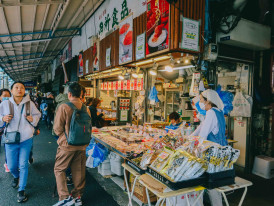
Tsukiji market stall.
Evening: Tokyo Station and Surrounding Areas
This station isn't just transportation, it's an experience in itself. The restored red brick façade reflects the intersection of Tokyo's past and present, while the underground passages connect you to some of the city's best food courts and department store basement food halls.
The station's depachika (department store food halls) offer an incredible introduction to Japanese cuisine variety.
From perfectly formed bento boxes to artisanal sweets, these spaces showcase food as art form. This is where locals actually shop for special occasion meals, not tourist destinations.
Day Two: Shibuya to Harajuku - Youth Culture and Creative Energy

Shibuya Scramble Crossing.
Morning: Shibuya Scramble and Observation Decks
Shibuya crossing is unavoidable, and honestly, you shouldn't avoid it. But instead of just walking through, experience it properly. The Shibuya Scramble Crossing represents Tokyo's organized chaos better than any other single location.
Start at Shibuya Sky, the observation deck that gives you perspective on the intersection below.
Watching the pedestrian ballet from above helps you understand the flow patterns that make this massive intersection function. It's choreography disguised as commuting.
Hungry for More Than Great Food?
Get a taste of Tokyo with a local host who curates your day around the dishes, and discoveries. you’ll love most.

Meiji Shrine.
Late Morning: Meiji Shrine and Yoyogi Park
A short walk from Shibuya's intensity brings you to Meiji Shrine, one of Tokyo's most important Shinto sites. The contrast is deliberate: ancient forest in the middle of the urban landscape, spiritual space adjacent to consumer culture.
Meiji shrine honors Emperor Meiji and Empress Shoken, representing Japan's transition into the modern era.
The shrine's forest was planted when it was built, making this a human-created "natural" space that feels completely "real."
Yoyogi Park adds to the peaceful feeling, especially if you're visiting on weekends when local musicians and dancers practice their routines.
This is where you see Tokyo residents at leisure, not just tourists checking off sites.
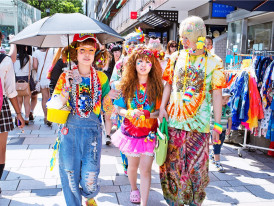
Harajuku.
Afternoon: Harajuku's Creative Subcultures
Harajuku gets dismissed as pure tourist theater, but dig deeper and you'll find genuine creative communities. Yes, the main strip sells costume-like clothing to visitors, but the side streets house independent designers and subculture meeting spots.
The area's reputation for extreme fashion has roots in real creative expression. While much of what you see today caters to visitors, you can still find stunning pieces if you know where to look.
This is prime people-watching territory. Find a coffee shop with street-facing windows and spend time observing the fashion choices, group dynamics, and creative energy that defines this neighborhood.
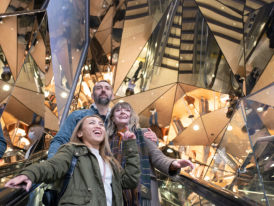
Omotesando Avenue.
Late Afternoon: Omotesando's Design Focus
Omotesando Avenue is where you'll find Japanese retail design at its most sophisticated. The stores here aren't just selling products, they're making architectural statements about brand identity and cultural values.
Each major fashion house has created a building that functions as both store and art installation. Even window shopping becomes an education in contemporary Japanese design thinking.
The area can feel expensive and exclusive, but much of the architectural interest is free to observe. You see how Japanese culture adapts international influences while maintaining distinct aesthetic principles.

Golden Gai.
Evening: Golden Gai Exploration
Golden Gai has old Tokyo compressed into two small alleys. These tiny bars, some seating only four people, preserve the intimate drinking culture that defined post-war Tokyo nightlife.
Every bar in Golden Gai has its own personality, often reflecting the master's interests or background. Some welcome foreigners enthusiastically, others maintain regulars-only policies.
The key is reading the atmosphere and respecting the space.
The cozy atmosphere and intimate scale make conversations possible in ways that larger bars don't. This is where you might end up discussing Tokyo life with locals or fellow travelers in ways that feel genuine rather than performative.
Day Three: Asakusa to Ueno - Traditional Culture and Hidden Creativity
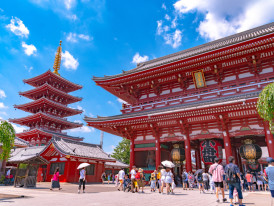
Sensoji Temple.
Early Morning: Sensoji Temple and Traditional Tokyo
Start day three in the historic Asakusa district, home to Tokyo's oldest established temple. Sensoji Temple, also known as Asakusa Kannon Temple, reflects Buddhism's deep roots in Japanese culture. The temple's history stretches back over 1,300 years, making it a cornerstone of Tokyo's spiritual landscape.
The walk to Sensoji through Nakamise-dori shopping street balances commercial and spiritual elements in ways that feel uniquely Japanese rather than tourist-oriented.
Vendors sell traditional snacks and religious items, creating atmosphere that supports rather than exploits the temple experience.
The temple complex works best early morning when you can observe local worshippers alongside international visitors. This timing also provides better photo opportunities and a more contemplative atmosphere.
Mid-Morning: Traditional Crafts and Street Food
Asakusa preserves traditional Japanese crafts in ways that feel living rather than museum-like. Small workshops throughout the district continue techniques passed down through generations, creating items for daily use rather than tourist souvenirs.
The street food scene here has traditional Japanese snacks that differ significantly from what you'll find in more modern neighborhoods.
These aren't social media-optimized treats, they're comfort foods that have sustained Tokyo residents for decades.
This is where you taste local food that prioritizes tradition over innovation. The flavors might seem subtle compared to more contemporary Japanese cuisine, but they are foundational elements of Tokyo's food culture.

Ueno park.
Afternoon: Ueno Park Cultural Complex
Ueno park is Tokyo's cultural heart, housing multiple museums, a zoo, and extensive green space that serves both locals and visitors.
This area really shows how Tokyo balances preservation with accessibility, making culture available rather than exclusive.
The park's significance goes beyond its individual attractions. During cherry blossom season, Ueno park becomes Tokyo's most important hanami (flower viewing) destination, with elaborate picnics that shows Japanese social traditions.
The variety within Ueno park means you can customize your experience based on interests and energy levels.
Art lovers can spend hours in the museums, while others might prefer wandering the market streets or relaxing in the park areas.

Ameyoko Market.
Late Afternoon: Ameyoko Market and Local Life
Ameyoko Market, located under the railway tracks near Ueno station, preserves post-war Tokyo's entrepreneurial spirit.
This area developed as a black market during the American occupation and evolved into a legitimate shopping district that maintains its scrappy, true character.
The market offers everything from vintage clothing to exotic foods, creating an atmosphere that feels genuinely local rather than tourist-oriented.
This is where Tokyo residents shop for specialty items and imported goods that aren't available in regular stores.
The market works best when you don't have specific goals. Browse, taste, and interact with vendors who often speak limited English but communicate enthusiasm for their products through demonstrations and samples.

Tokyo Skytree.
Evening: Tokyo Skytree and Sumida River
End your Tokyo itinerary with Tokyo Skytree, the city's newest iconic structure. While some locals dismiss it as tourist-oriented, the observation decks provide perspective on Tokyo's scale and complexity that's hard to grasp from street level.
The Skytree area also offers dining and shopping options that reflect contemporary Tokyo culture. The complex surrounding the tower shows current Japanese design and retail trends, giving you a glimpse of the creativity in Japan.
The contrast between Skytree's ultra-modern architecture and the traditional neighborhoods below captures Tokyo's essential character, innovation built on deep cultural foundations.
Practical Tokyo Tips for First Timers

JR Yamanote Line train.
Getting Around: Transportation Basics
Tokyo's transportation system seems intimidating but follows logical patterns once you understand the basics. The JR Yamanote Line connects all major districts in a loop, making it your primary navigation tool for 3 days in Tokyo.
Most train stations have English signage, and station staff often speak basic English. Don't hesitate to ask for help—Tokyo residents generally appreciate polite requests for assistance.
Money and Payment Systems
Japanese yen remains the primary currency, though card acceptance has improved significantly. Many restaurants, especially smaller ones, remain cash-only. Convenience stores have reliable ATMs that accept international cards.
You should withdraw larger amounts because frequent small withdrawals will become more expensive over your stay. Always carry cash, you'll encounter many places that don't take cards, and remember that tipping is not a thing in Japan.

Tokyo skyline.
Where to Stay: Neighborhood Considerations
Location significantly impacts your Tokyo itinerary efficiency. Each area offers different advantages depending on your priorities and travel style.
Accommodation area recommendations:
- Shibuya/Shinjuku: Central location, vibrant nightlife, excellent transportation
- Ginza: Upscale area, close to Tsukiji, excellent shopping and dining
- Asakusa: Traditional atmosphere, budget-friendly, less central
- Harajuku/Omotesando: Creative energy, youth culture, design focus
Park Hyatt Tokyo in Shinjuku personifies luxury accommodation with iconic city views, but many mid-range hotels offer excellent service and convenient locations. Consider your budget against location convenience when booking.
Not Just a Food Tour - A Table-Side Introduction to Tokyo
Join a local for a trip tailored to your taste, pace, and curiosity. No scripts, just shared stories and great bites.

Tourists enjoying Japanese food.
Food Culture Navigation
You'll find that Japanese food varies dramatically by neighborhood and restaurant type. Understanding basic etiquette helps you enjoy meals without cultural confusion. For example, you're encouraged to slurp because this shows appreciation. Also, don't stick your chopsticks upright in rice or pass food chopstick-to-chopstick.
Cat cafes and animal cafes require reservations and have specific interaction rules. These experiences work better when you understand them as cultural phenomena rather than just tourist activities.
Convenience Store Culture
Convenience stores in Tokyo function as neighborhood centers, offering services far beyond typical retail. They're essential resources for travelers who understand how to use them effectively.
The prepared food quality at these stores often surprises visitors. These aren't gas station sandwiches, they're carefully prepared meals that many Tokyo residents rely on for daily nutrition.
Communication and Language
English signage is common in tourist areas, but learning basic Japanese phrases improves your experience significantly. Most importantly, politeness and respect transcend language barriers.
Bowing slightly when greeting or thanking people shows cultural awareness and is always appreciated, even from foreign visitors.
More than 26,233 5-star reviews and counting
26,233+ 5-Star Reviews and Counting
Trusted and recommended by travelers worldwide.
Food-Forward Tokyo: What Makes This City Special
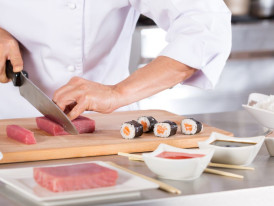
Sushi chef carefully preparing fish.
Understanding Japanese Food Culture
Japanese food in Tokyo transcends simple sustenance, it's cultural values around seasonality, craftsmanship, and respect for ingredients. Understanding these principles enhances every meal during your 3 days in Tokyo.
The concept of shokunin (artisan craftsperson) applies to food preparation throughout Tokyo. Whether you're eating at a high-end restaurant or grabbing a ramen bowl from a street stall, you're likely experiencing someone's dedicated craft.
This approach means that even simple meals carry cultural weight.
Regional Specialties Within Tokyo
Tokyo's neighborhoods each offer distinct food experiences that reflect different aspects of Japanese cuisine. Understanding these regional differences helps you plan meals that lets you taste the city's culinary diversity.
Street Food and Casual Dining
Street food in Tokyo differs from other Asian cities, it's more regulated, seasonal, and often connected to festivals or specific locations. The quality remains consistently high due to strict food safety standards.
Many of the best casual dining experiences happen in small neighborhood restaurants that seat fewer than ten people. These places often specialize in one or two dishes prepared to perfection over decades.

Vending machine.
Vending machines in Tokyo offer everything from hot coffee to complete meals, representing the city's approach to convenience and technology integration. These aren't just tourist curiosities—they're essential infrastructure that Tokyo residents rely on daily.
The variety and quality of vending machine options reflects Japanese attention to detail and consumer service. Even a simple coffee purchase becomes an experience in precision and reliability.
Taste Tokyo Through a Local’s Eyes
Skip the script. Get a personalized experience shaped around your appetite, your pace, and your idea of fun.
Hidden Creative Scenes: Beyond the Tourist Trail
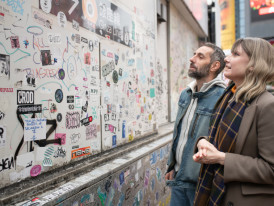
Tokyo art.
Independent Art Spaces and Galleries
Tokyo's creative energy extends far beyond obvious cultural attractions. Independent galleries, artist-run spaces, and pop-up exhibitions throughout the city showcase contemporary digital art and experimental work that rarely appears in travel guides.
These spaces often run on irregular schedules and change locations frequently, making them challenging to find but rewarding in the end. They represent Tokyo's underground creative culture that continues regardless of tourist attention.
Music and Performance Venues
Tokyo's music scene ranges from tiny basement clubs to major concert halls, with everything from traditional Japanese instruments to cutting-edge electronic music. The diversity reflects Tokyo's role as both cultural preserver and innovation center.
Maker Spaces and Craft Communities
Traditional crafts continue to evolve in Tokyo through artist communities that blend historical techniques with contemporary applications. These workshops and maker spaces often welcome visitors interested in learning about Japanese craft traditions.

Tokyo Tower.
Tokyo Tower's Enduring Appeal
Tokyo Tower is the city's beloved red-and-white landmark, predating the more famous Skytree by decades.
Built in 1958 as a broadcasting antenna, this Eiffel Tower-inspired structure became Tokyo's symbol during the post-war economic boom. While newer observation decks offer higher views, Tokyo Tower maintains a nostalgic charm that locals cherish.
The surrounding area blends seamlessly with traditional neighborhoods, creating photo opportunities that capture old and new Tokyo in single frames.
Visiting at sunset will show you why this tower remains emotionally significant. It represents Tokyo's resilience and ambition during a transformative era. The views remind you that modern Tokyo grew around, not despite, its historical foundations.
Planning Your Tokyo Itinerary: Practical Considerations

Tokyo in autumn.
Seasonal Planning and Weather
Visiting Tokyo experiences vary dramatically by season, affecting everything from food availability to crowd levels. Each season offers distinct advantages for different types of travelers.
Your Tokyo itinerary should account for seasonal closures, weather-related comfort, and special events that might enhance or complicate your plans.
Budget Planning for 3 Days
3 days in Tokyo costs vary significantly based on accommodation, dining choices, and activity preferences. Understanding price ranges helps you budget effectively without compromising essential experiences.
Budget breakdown estimates (per person, USD):
- Budget approach: $150-200 per day (hostels, store meals, free attractions)
- Mid-range: $300-400 per day (business hotels, restaurant meals, paid attractions)
- Luxury: $500+ per day (high-end hotels, premium dining, exclusive experiences)
Transportation costs remain relatively consistent regardless of budget level, while accommodation and dining offer the most variation in price and experience quality.
Essential Tokyo Experiences for Creative Travelers

Digital art in Akihabara, Tokyo.
Art and Design Immersion
Tokyo's digital art scene extends beyond teamLab's famous installations to include smaller galleries and experimental spaces throughout the city. These venues show how Japanese artists integrate technology with traditional aesthetic principles.
Culinary Deep Dives
Food exploration during 3 days in Tokyo should include both high-end experiences and everyday food culture. The contrast helps you understand the full spectrum of Tokyo's food scene.
Cultural Interaction Opportunities
Japanese culture becomes more accessible through structured interaction opportunities that don't require language fluency. These experiences provide cultural context for the sights and food you encounter.
What if Tokyo’s Food Scene Came With a Local Friend?
City Unscripted crafts your perfect food-filled day - no scripts, no crowds, just you.
Unique Tokyo Experiences for Short Visits

Cat cafés.
Cat Cafés and Animal Interaction
Cat cafés in Tokyo originated from urban living constraints that prevent many residents from keeping pets. These spaces provide animal interaction in controlled environments that benefit both humans and animals.
The popularity of animal cafes reflects Tokyo's urban lifestyle constraints and Japanese cultural attitudes toward animal welfare. These experiences work best when approached with genuine interest in animal interaction rather than just photo opportunities.
Technology and Innovation Showcases
Tokyo's reputation for technological innovation appears in unexpected places throughout the city. From advanced vending machines to interactive retail experiences, technology integration happens seamlessly in daily life.
Seasonal Festivals and Events
Just a few days in Tokyo might coincide with local festivals that provide insight into community culture beyond tourist attractions. These events show how Tokyo neighborhoods maintain distinct identities within the larger metropolitan area.
Seasonal event possibilities:
- Summer festivals: Street celebrations with traditional food and performances
- Winter illuminations: Light displays that completely transform urban spaces
- Spring cherry blossom events: Community celebrations in parks and temples
- Autumn cultural festivals: Art, music, and craft celebrations
Advanced Tokyo Navigation for Efficient Travel
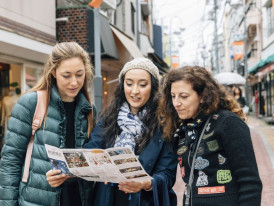
Tourists looking at map.
Understanding Tokyo's Geographic Logic
Tokyo's layout follows historical development patterns that aren't immediately obvious to visitors. Understanding these geographic relationships helps you plan efficient routes and avoid unnecessary backtracking during your Tokyo itinerary.
Geographic orientation basics:
- Imperial Palace: Geographic center with major districts radiating outward
- Yamanote Line: Circular train line connecting major centers
- River systems: Sumida and other rivers create natural district boundaries
- Historical development: Old Edo areas vs. modern development zones
The train station locations often mark historical town centers that were connected as Tokyo expanded. This knowledge helps explain why certain areas feel distinctly different despite geographic proximity.
Rush Hour and Crowd Management
Japanese culture includes sophisticated systems for managing crowded public spaces. Understanding these unwritten rules helps you enjoy Tokyo efficiently while respecting local customs.
Crowd navigation strategies:
- Platform etiquette: Stand aside for exiting passengers before boarding
- Escalator rules: Stand left, walk right (opposite of some other countries)
- Peak hour avoidance: Plan activities to minimize rush hour travel
- Alternative routes: Use multiple train lines to avoid bottlenecks
Station Navigation and Connectivity
Major Tokyo stations function as underground cities with shopping, dining, and service options. Learning to explore these spaces efficiently saves time and provides backup options when plans change.
Major station features:
- Multiple train lines: Connections between different railway companies
- Underground shopping: Retail and dining options within station complexes
- Service centers: Information, luggage storage, and tourist assistance
- Emergency facilities: First aid, lost and found, and emergency services
Leon made sure we saw everything we wanted and also introduced us to Tokyo’s amazing street food, which was a highlight!R. Keith, Tokyo, 2025
Final Recommendations: Making the Most of Your Time

Tokyo.
Essential Experiences You Cannot Miss
After years of exploring Tokyo and guiding friends through their first visits, certain experiences consistently create lasting memories. These aren't necessarily the most famous attractions, they're the moments that help visitors understand what makes Tokyo special.
Non-negotiable Tokyo experiences:
- Early morning at Tsukiji Fish Market: Food culture at its best
- Quiet temple time: Spiritual space within urban intensity
- Tiny bar conversation: Intimate social interaction with locals
- Convenience store meal: Quality food culture at street level
- Park observation: Watching Tokyo residents at leisure
Common Mistakes to Avoid
First timers often make planning mistakes that reduce their Tokyo experience quality. Learning from others' experiences helps you avoid common pitfalls.
Planning mistakes to avoid:
- Over-scheduling: Trying to see everything instead of experiencing anything deeply
- Ignoring seasons: Not adapting plans to weather and seasonal variations
- Tourist trap focus: Prioritizing Instagram spots over meaningful experiences
- Language anxiety: Avoiding interaction due to communication concerns
- Budget extremes: Either overspending on unnecessary luxuries or missing worthwhile experiences
Creating Lasting Memories Beyond Photos
Such an experience as visiting Tokyo for the first time creates memories that extend far beyond social media documentation. The most meaningful travel memories often come from unexpected moments rather than planned photo opportunities.
Memory-making strategies:
- Engage with locals: Simple interactions create lasting impressions
- Try unfamiliar foods: Taste memories connect you to place more than visual memories
- Walk without destinations: Find neighborhoods through wandering
- Sit and observe: Spend time watching daily life unfold around you
- Learn basic customs: Participate in cultural practices rather than just observing
Extending Your Tokyo Experience
Three days provides an introduction to Tokyo, but many visitors want to explore further after their initial experience. Planning future visits or extending current trips requires understanding what you've missed and what deserves deeper exploration.
Areas for future exploration:
- Outer Tokyo neighborhoods: Districts like Kichijoji, Daikanyama, and Nakameguro
- Day trips: Mount Fuji, Kamakura, and Nikko accessible for longer itineraries
- Seasonal experiences: Cherry blossoms, autumn leaves, summer festivals
- Specialized interests: Deep dives into particular aspects of local culture
Shop Tokyo’s Unexpected Side
Explore quirky stores and hidden finds with a local who personalizes the experience to your style.
Tokyo's Lasting Impact
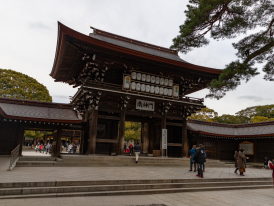
Meiji Shrine.
Well-planned and personal Tokyo experiences change how you think about cities, food, culture, and travel. This vibrant city runs on principles that challenge assumptions about urban life, social interaction, and cultural preservation.
The experiences you've gathered - from the early morning energy at the fish market to the intimate conversations in Golden Gai - represent different facets of a unified cultural approach to urban living.
Tokyo teaches visitors that tradition and innovation aren't opposing forces. Instead, they're complementary elements that create something entirely unique. The city's ability to maintain distinct neighborhood characters while functioning as a unified metropolitan area offers lessons that extend far beyond travel.
What you take home from Tokyo:
- Appreciation for craftsmanship: The Shokunin spirit applies to everything from sushi preparation to train scheduling
- Understanding of social harmony: How millions of people coordinate daily life through mutual respect and consideration
- Design consciousness: The way Japanese aesthetics influence everything from architecture to food presentation
- Cultural adaptability: How Tokyo integrates international influences while maintaining cultural identity
Your Tokyo itinerary ends, but Tokyo's influence continues. The precision you experienced in restaurant service, the beauty you noticed in everyday design choices, and the kindness you encountered from strangers all reflect cultural values that travelers often want to incorporate into their own lives.
Tokyo succeeds as a travel destination because it offers experiences that feel both exotic and familiar, ancient and cutting-edge, overwhelming and intimate. Whether you spend two days in Tokyo, or opt for three (or more), there is enough material for years of reflection and planning for return visits.
The city's greatest gift to visitors might be the realization that urban life can prioritize beauty, craft, and human connection without sacrificing efficiency or innovation. Tokyo proves that cities can be both massive and intimate, traditional and progressive, serious and playful.
Eat Curious. Explore Freely. Make Tokyo Yours.
SEE TOKYO EXPERIENCESYour Tokyo Food Experience, Unscripted
Explore Tokyo with a local host and a plan built around you, not the crowds, not the script.
Chat With a Tokyo Local
Got questions? Speak to a host who actually lives there and can plan a trip that fits you, not a template.












